Indiana's housing market in 2016: Strong demand, tight supply
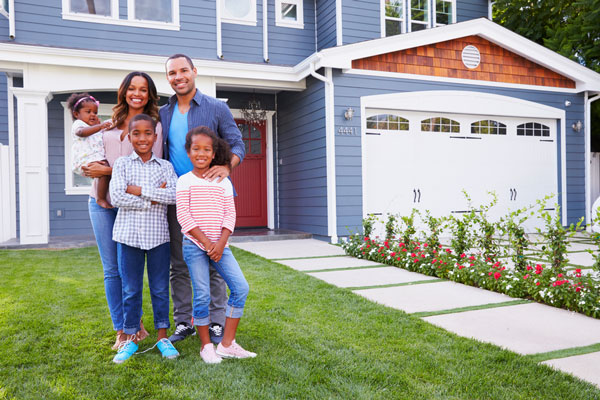
Indiana’s key housing market indicators are all pointed in the right direction.
According to most key indicators, the Indiana housing market has continued to strengthen in the first half of 2016. Existing home sales, for instance, are approaching the state’s pre-Great Recession peak and Indiana’s foreclosure rate dropped below the 2 percent mark for the first time since 2000 (see Table 1).
Table 1: Indiana housing market by the numbers
| Indicator | U.S. | Indiana |
|---|---|---|
| Existing home sales between July 2015 and June 2016, year-over-year change | 5.1% | 6.7% |
| House price appreciation, 2015 Q1 to 2016 Q1 | 5.5% | 4.7% |
| Residential building permits between July 2015 and June 2016, year-over-year change | 3.1% | 7.4% |
| Foreclosure rate, 2016 Q2 | 1.6% | 1.8% |
| Months’ supply of inventory, June 2016 | 4.6 | 4.9 |
| Rental vacancy rate, 2016 Q2 | 6.7% | 10.0% |
Sources: Indiana Association of Realtors, National Association of Realtors, Federal Housing Finance Agency, U.S. Census Bureau and the Mortgage Bankers Association
While buyer demand surges, the inventory of homes on the market continues to dwindle. In fact, the number of homes for sale in the state in June 2016 was down nearly 16 percent compared to the same month a year earlier—the sixth consecutive month of double-digit declines in this measure, according to the Indiana Association of Realtors.
This seller’s market is driving strong house price gains and beginning to breathe a little life into the residential construction industry. This article will assess the current state of Indiana’s housing market by looking at the latest data in each of these areas and placing the numbers in historical context.
Home sales at record level in second quarter
Driven by exceptionally low mortgage rates, an improving economy and a dramatic slowdown in new home construction in recent years, the market for existing homes is now as hot as it’s ever been. Over the 12-month period ending in June 2016, Indiana registered 83,700 existing home sales—a 6.7 percent increase over the previous year and the state’s largest four-quarter total since the middle of 2007 (see Figure 1).
Looking at just the second quarter of 2016, Indiana posted 25,770 existing home sales—the state’s largest tally on record for one quarter (data on Indiana home sales goes back to 2004). The state’s previous high-water mark was 25,240 sales in the second quarter of 2006.
Figure 1: Indiana home sales, moving four-quarter total
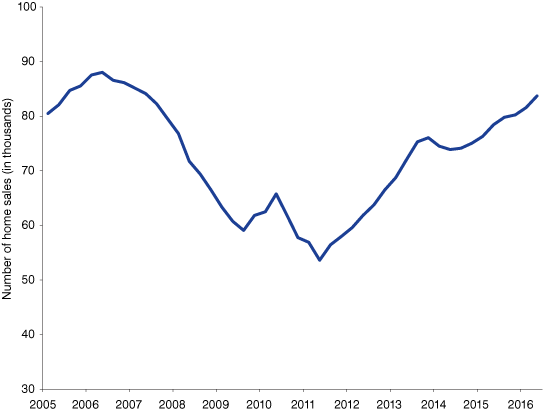
Source: Indiana Association of Realtors
House prices continue to climb
Given this extreme seller’s market, it is little surprise that house prices are also seeing strong growth (see Figure 2). For the month of June 2016, the median sales price for existing homes in the state was $147,900—a 3.8 percent increase over the previous June. This was the 19th consecutive month that the state’s median sales price increased more than 3 percent year-over-year (10 of these months saw gains above 5 percent).
Figure 2: Median sales price and months' supply of inventory, 12-month moving average
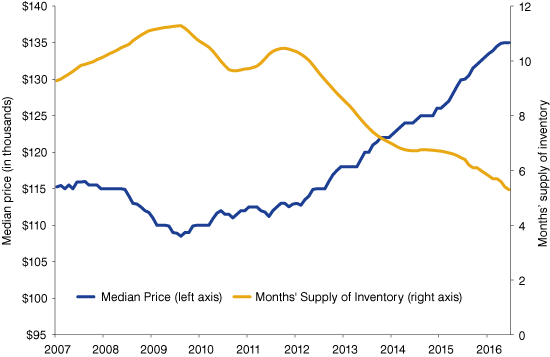
Source: Indiana Association of Realtors
Other measures show that Indiana’s house prices are improving as well. According to the Federal Housing Finance Agency’s House Price Index (HPI), Indiana has seen price appreciation for 17 consecutive quarters dating back to early 2012, and the state’s home prices in the first quarter of 2016 are up 4.7 percent year-over-year. This rate of appreciation ranked 25th-fastest nationally. Among Indiana’s neighbors, Michigan (10.9 percent), Kentucky (5.9 percent) and Ohio (5.5 percent) saw stronger rates of growth, while Illinois (3.8 percent) trailed Indiana.
It is important to note that comparing states based on one-year growth rates can be misleading. States like Michigan and Ohio are outpacing Indiana now because they are rebounding from far more severe price declines during the housing bust. House prices in Michigan declined by 45 percent after the crash and Ohio had a drop of 25 percent. Indiana had a comparatively mild 12 percent slide in prices between 2007 and 2011. In the first quarter of 2016, Indiana house prices were more than 5 percent above the pre-recession peak (see Figure 3). House prices in Michigan and Ohio, by contrast, are still 16.1 percent and 7.7 percent below their respective peaks.
Figure 3: House price index
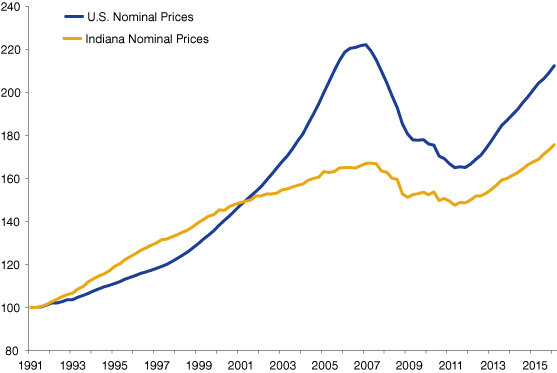
Source: Federal Housing Finance Agency, House Price Index (expanded data series, seasonally adjusted)
Indiana foreclosure rate at lowest level since 2001
Another factor helping to boost house prices is the dramatic decline in foreclosures. According to the Mortgage Bankers Association, the state’s foreclosure rate has declined more than 3.1 percentage points from 4.94 in the fourth quarter of 2011 to 1.79 in mid-2016, which is the state’s lowest rate since 2000 (see Figure 4). Even with this drop, however, Indiana’s foreclosure rate remains slightly above the U.S. average and ranks 19th-highest among states.
Figure 4: Share of mortgages in foreclosure
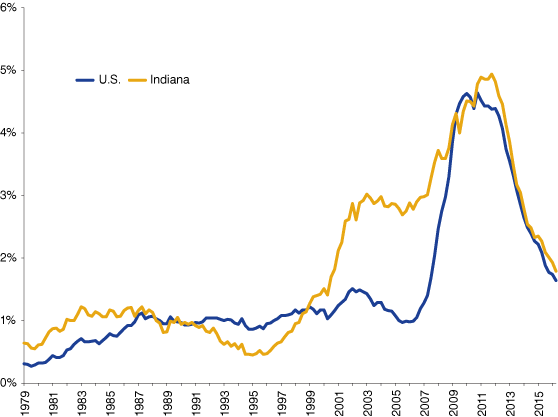
Source: National Delinquency Survey, Mortgage Bankers Association
Residential construction remains weak
With inventory so low and prices rising at a strong clip, Indiana is finally seeing an uptick in new construction. Through the first half of 2016, building permits were issued for roughly 8,600 new units in Indiana, a 9 percent increase over the same time last year. The growth in new single-family units has been even stronger, with a jump of 15.3 percent year-over-year in the first half of 2016. Comparing the same periods, the number of permits issued for multi-family units in the state is down 11 percent.
While there have been modest gains in 2016, residential construction is still weak by historical standards. The gap between the number of existing home sales and permits for new single-family homes highlights the extent to which construction is lagging. From 1988 to 2005, there was a fairly consistent ratio of approximately two existing home sales for each single-family housing permit in Indiana (see Figure 5). In 2015, however, that ratio was roughly six-to-one. This gap has held steady so far in 2016, as the boost in construction has been matched by an uptick in existing home sales.
Figure 5: Indiana existing home sales and single-family housing permits
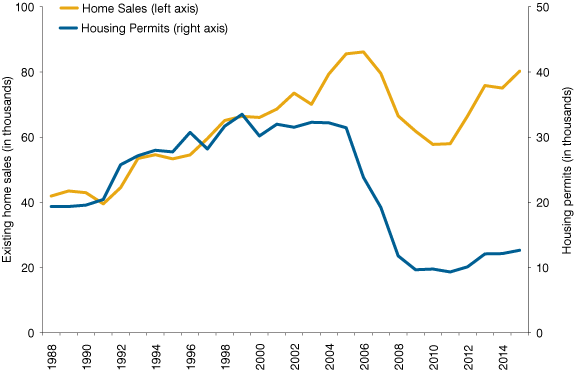
Source: U.S. Census Bureau, Moody’s Economy.com, Indiana Association of Realtors
Looking ahead
Indiana’s key housing market indicators are all pointed in the right direction. In particular, existing home sales, house prices and the foreclosure rate are in good shape. With Indiana’s economy on solid footing and mortgage rates likely to remain low for a while longer, these measures will likely remain strong. Residential construction has shown some improvement as well, but it remains the last sector of the state’s housing market to see a true rebound after the recession. The extremely low inventory of homes for sale, along with climbing prices, suggests this rebound shouldn’t be too far off, but only time will tell.
